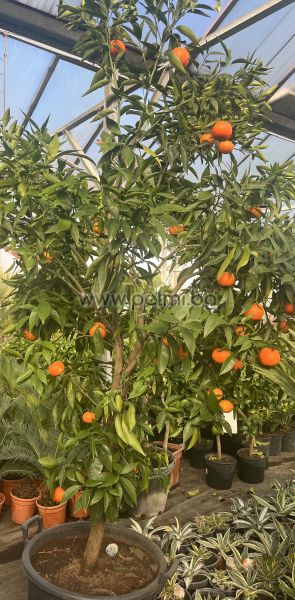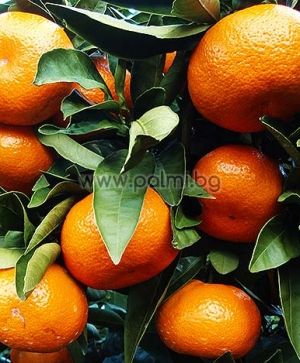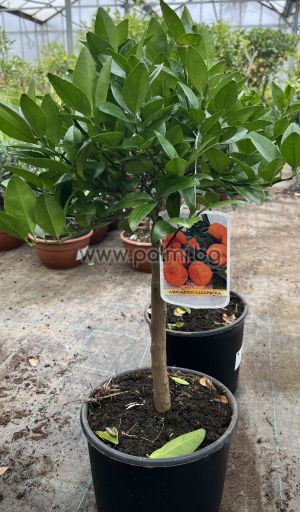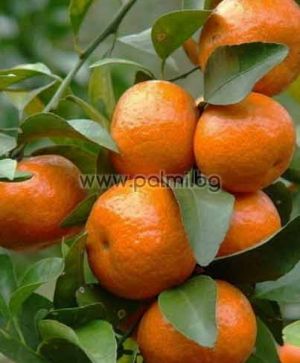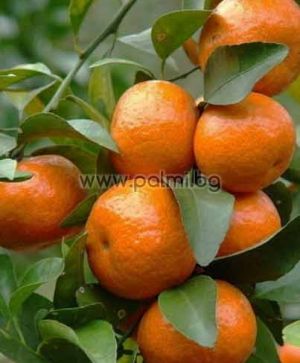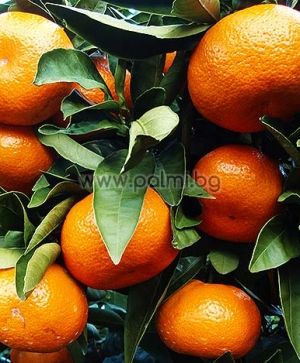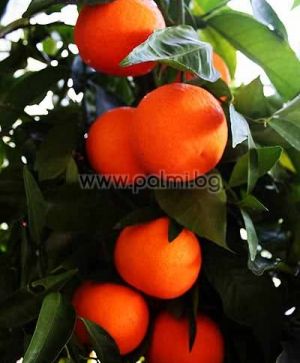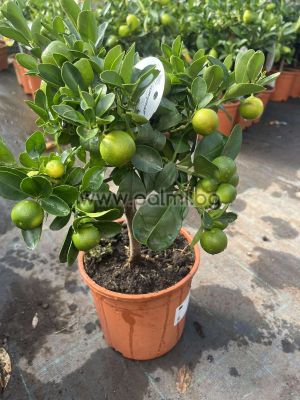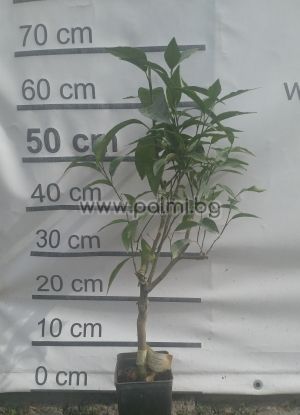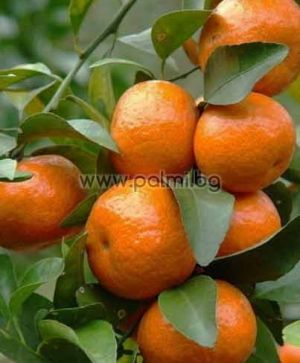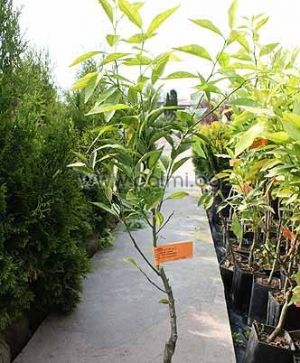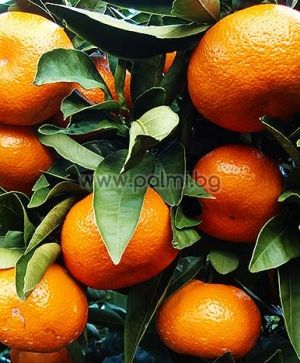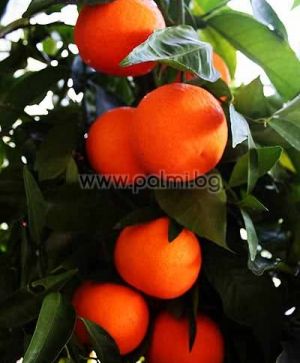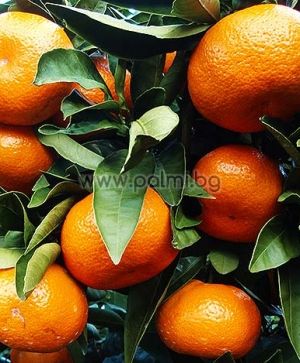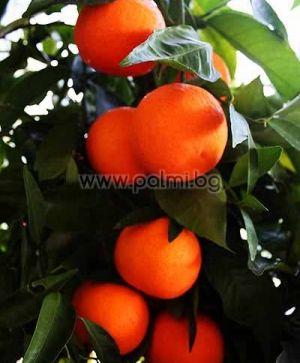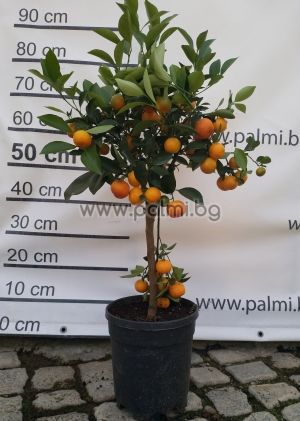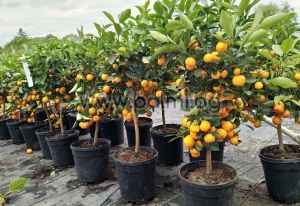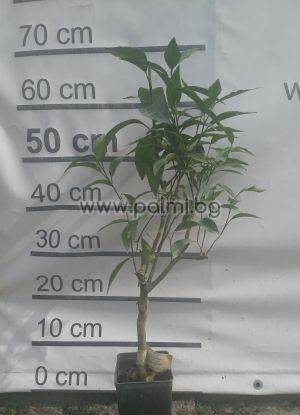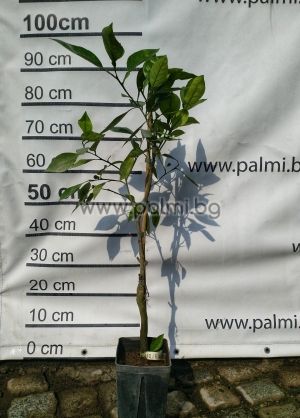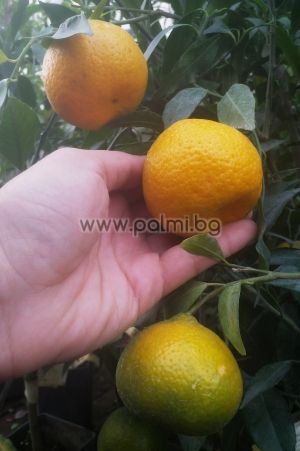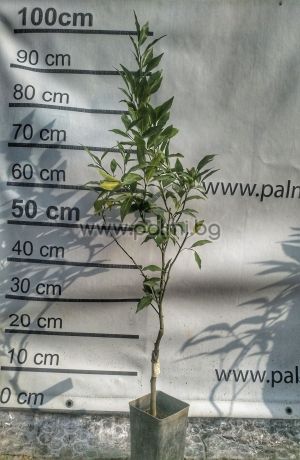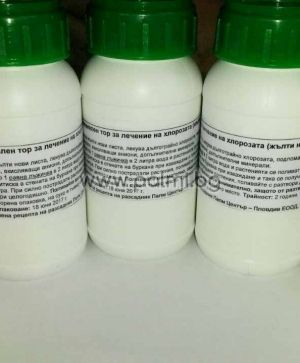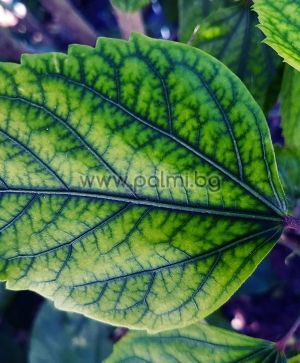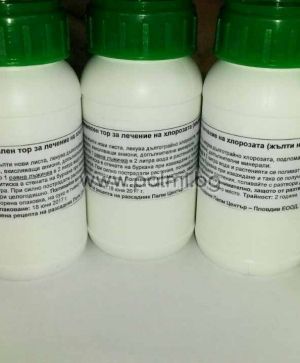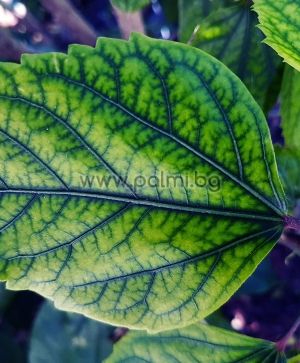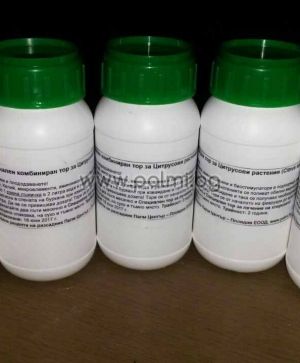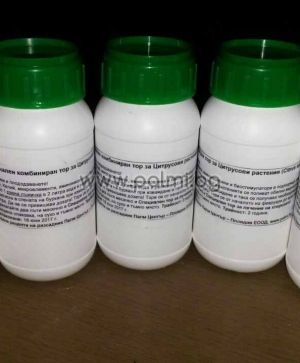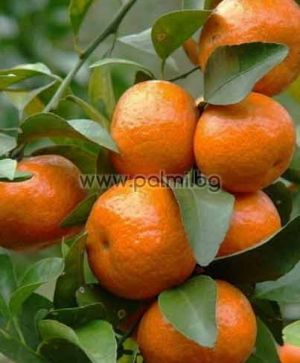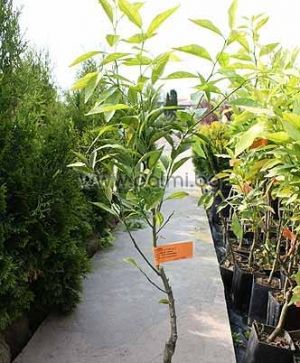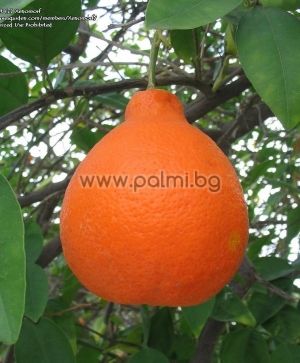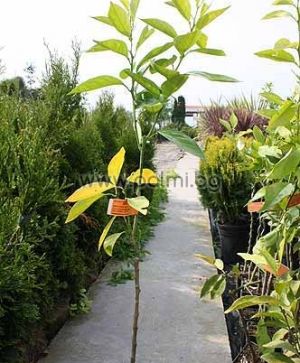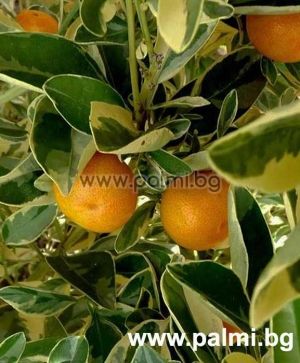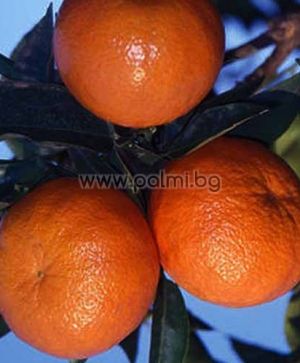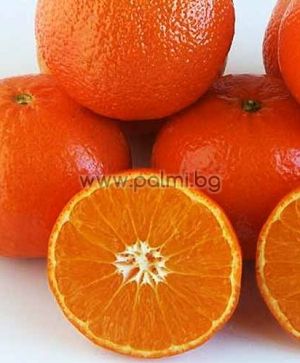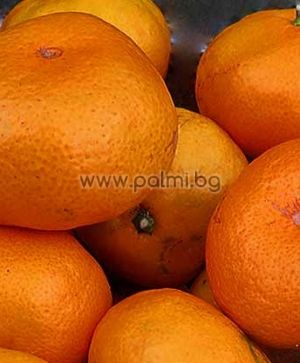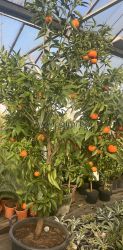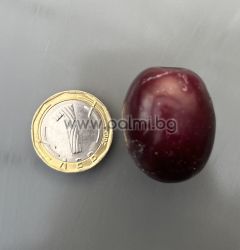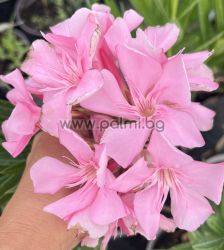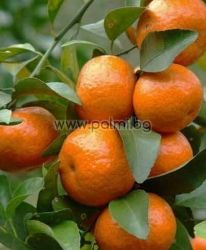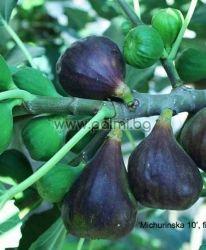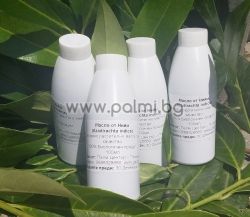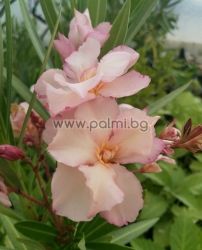Mandarins, Tangerines, Tangelos varieties
Mandarin, Tangerine and Tangelo citrus varieties. We have a good assortment of Mandarin, Tangerine and Tangelo varieties - early, middle and late ripening.
Mandarin Clementine Rubino V.C.R.
Important notice! Most citrus plants on the market are produced for planting in orchards in the Mediterranean countries. They have a large overall height, have high graft and are difficult to shape and support at home. Rootstocks on which they are grafted are very fast growing, which is fine for the open ground in the subtropics, but is not desirable when growing in pot in the temperate climate.
All our small citrus plants are produced specifically for the Bulgarian market and are ideally suited for home cultivation. The rootstocks cause compact growth, grafts are low and this allows making an excellent shape of the crown, to be suitable for growing in pots. The used rootstocks are trifoliate orange (Poncirus trifoliata 'Flying Dragon') and Volkamer lemon, Citrus volkameriana. Trifoliate orange is frost-hardy to -25°C, and significantly increases the cold resistance of plants grafted on it.
Citrus x Clementine
Mandarin Clementine from Botanical Garden - Plovdiv, Bulgaria
Clementines are a hybrid of mandarin and sweet orange, sometimes called Algerian Tangerine. In just a century, this hybrid has grown to a group of varieties that cover several months of maturing and are among the most popular dessert Mandarins.
Characteristics of the fruits of the Clementines are:
- - strong flavor
- - juicy with high sugar content
- - low acidity
- - thin peel
- - separate in 7 to 12 segments
- - ripen in late November to late January
- - seedless
Typical of clementines are their seedless fruits. But it depends on growing conditions and agrotechnics. Regular fertilization and cross-pollination with other citrus varieties are results in a different number of seeds inside the fruits.
As with all other Citrus plants, the orange is susceptible to scales and spider mites and needs to be sprayed twice a year.
In winter it will need a cool place with temperatures 0-10 degrees Celsius. If the temperature is higher, the leaves usually fall off. In summer it needs to be outside and abundantly watered.
Much more information about all citrus species is available on our forum:
Availability: 5 pcs
Mandarin Reticulata
Important notice! Most citrus plants on the market are produced for planting in orchards in the Mediterranean countries. They have a large overall height, have high graft and are difficult to shape and support at home. Rootstocks on which they are grafted are very fast growing, which is fine for the open ground in the subtropics, but is not desirable when growing in pot in the temperate climate.
All our small citrus plants are produced specifically for the Bulgarian market and are ideally suited for home cultivation. The rootstocks cause compact growth, grafts are low and this allows making an excellent shape of the crown, to be suitable for growing in pots. The used rootstocks are trifoliate orange (Poncirus trifoliata 'Flying Dragon') and Volkamer lemon, Citrus volkameriana. Trifoliate orange is frost-hardy to -25°C, and significantly increases the cold resistance of plants grafted on it.
Citrus Reticulata
Hybrid Mandarin Kukle from Botanical Garden - Plovdiv, Bulgaria
Citrus reticulata Mandarin – Aromatic Citrus Tree for Home and Garden Growing
Citrus reticulata is the classic mandarin tree – one of the most beloved citrus fruits, known for its naturally sweet flavor and refreshing aroma. The tree has a compact shape, dense green foliage, and excellent productivity, making it ideal for both beginner and experienced gardeners.
The fruits feature a thin, easy-to-peel skin and juicy, vitamin-rich segments full of antioxidants. This mandarin variety is perfect for growing in pots, winter gardens, terraces, or small yards, and with proper care it produces a reliable harvest even in cooler climates.
Advantages of Citrus reticulata
-
Sweet, fragrant fruits perfect for fresh consumption
-
Compact and easy to grow, suitable for shaping
-
Ideal for pots and containers on balconies and terraces
-
Early and regular fruiting
-
High decorative value thanks to its deep-green foliage and bright orange fruits
Growing Requirements
The mandarin prefers a sunny, sheltered location, well-drained soil, and regular watering. Protect the plant from temperatures below –3°C, or overwinter it indoors in colder regions.
Bring a touch of Mediterranean charm to your home or garden with Citrus reticulata – an easy-to-grow mandarin tree that delights with abundant, aromatic fruit and attractive appearance.
Availability: 10 pcs
Hybrid Mandarin Cleopatra
Important notice! Most citrus plants on the market are produced for planting in orchards in the Mediterranean countries. They have a large overall height, have high graft and are difficult to shape and support at home. Rootstocks on which they are grafted are very fast growing, which is fine for the open ground in the subtropics, but is not desirable when growing in pot in the temperate climate.
All our small citrus plants are produced specifically for the Bulgarian market and are ideally suited for home cultivation. The rootstocks cause compact growth, grafts are low and this allows making an excellent shape of the crown, to be suitable for growing in pots. The used rootstocks are trifoliate orange (Poncirus trifoliata 'Flying Dragon') and Volkamer lemon, Citrus volkameriana. Trifoliate orange is frost-hardy to -25°C, and significantly increases the cold resistance of plants grafted on it.
Citrus Cleopatra
Hybrid Mandarin Cleopatra from Botanical Garden - Plovdiv, Bulgaria
English Translation — Citrus Mandarina Cleopatra
Citrus Mandarina Cleopatra – a hardy mandarin with decorative fruits and a compact crown
Citrus Mandarina Cleopatra, also known as Cleopatra Mandarin, is one of the most resilient and adaptable citrus varieties. It is valued both as a decorative plant and as a fruit-bearing tree with small, aromatic mandarins. This variety is perfect for growers looking for a low-maintenance citrus with strong ornamental appeal.
Characteristics
-
Fruits: small, bright orange, with a firm peel and strong citrus aroma.
-
Taste: refreshing and slightly tangy — excellent for drinks, marmalades, and flavoring.
-
Blooming: delicate white flowers with an intense fragrance appearing once or twice a year.
-
Growth: compact and dense, ideal for shaping and container growing.
-
Foliage: dark green, glossy, and highly decorative throughout the year.
-
Hardiness: one of the most durable citrus types, tolerating lower temperatures and various soil types.
-
Uses: also widely used as a rootstock thanks to its excellent adaptability.
Advantages
-
✔ Extremely hardy and low-maintenance
-
✔ Perfect for beginners and container growing
-
✔ Compact growth suitable for balconies, terraces, and winter gardens
-
✔ Decorative small fruits that stay long on the tree
-
✔ Strong growth and excellent adaptability
Availability: 10 pcs
Hybrid Mandarin Kukle(Citrus Margarita x citrus Clementina)
Important notice! Most citrus plants on the market are produced for planting in orchards in the Mediterranean countries. They have a large overall height, have high graft and are difficult to shape and support at home. Rootstocks on which they are grafted are very fast growing, which is fine for the open ground in the subtropics, but is not desirable when growing in pot in the temperate climate.
All our small citrus plants are produced specifically for the Bulgarian market and are ideally suited for home cultivation. The rootstocks cause compact growth, grafts are low and this allows making an excellent shape of the crown, to be suitable for growing in pots. The used rootstocks are trifoliate orange (Poncirus trifoliata 'Flying Dragon') and Volkamer lemon, Citrus volkameriana. Trifoliate orange is frost-hardy to -25°C, and significantly increases the cold resistance of plants grafted on it.
Citrus Kukle
Hybrid Mandarin Kukle from Botanical Garden - Plovdiv, Bulgaria
Citrus Kucle – a unique citrus hybrid with exceptional ornamental and fruit qualities
Citrus Kucle is a rare and impressive citrus variety, created by crossing kumquat and clementine. This hybrid combines the best of both parents – the ornamental charm of kumquat and the delightful fragrance of clementine. The result is a compact, evergreen plant that produces small orange fruits with a fine citrus aroma and excellent flavor.
Characteristics of Citrus Kucle
-
Compact, evergreen plant with a dense canopy – perfect for container growing.
-
Thornless, safe and easy to maintain.
-
Fragrant white blossoms, blooming generously throughout the season.
-
Fruiting: small, orange, slightly oval fruits that can be eaten whole, including the peel.
-
Taste: a balanced mix of kumquat’s refreshing acidity and clementine’s gentle sweetness.
-
Cold tolerance: withstands temperatures down to approx. –4°C, suitable for winter gardens and warmer outdoor climates.
-
Size: reaches about 2–3 m outdoors, remaining more compact in pots.
Advantages of Citrus Kucle
-
Perfect for decorative arrangements, terraces, patios, and interior spaces.
-
Produces edible fruits ideal for fresh consumption, jams, drinks, and desserts.
-
Easy-care variety with strong resilience and long-lasting ornamental appeal.
-
Suitable for both beginners and experienced citrus enthusiasts.
As with all other Citrus plants, the orange is susceptible to scales and spider mites and needs to be sprayed twice a year.
In winter it will need a cool place with temperatures 0-10 degrees Celsius. If the temperature is higher, the leaves usually fall off. In summer it needs to be outside and abundantly watered.
Much more information about all citrus species is available in Bulgarian on our forum:
Availability: 40 pcs
Mandarin Clementine Rubino V.C.R.
Important notice! Most citrus plants on the market are produced for planting in orchards in the Mediterranean countries. They have a large overall height, have high graft and are difficult to shape and support at home. Rootstocks on which they are grafted are very fast growing, which is fine for the open ground in the subtropics, but is not desirable when growing in pot in the temperate climate.
All our small citrus plants are produced specifically for the Bulgarian market and are ideally suited for home cultivation. The rootstocks cause compact growth, grafts are low and this allows making an excellent shape of the crown, to be suitable for growing in pots. The used rootstocks are trifoliate orange (Poncirus trifoliata 'Flying Dragon') and Volkamer lemon, Citrus volkameriana. Trifoliate orange is frost-hardy to -25°C, and significantly increases the cold resistance of plants grafted on it.
Citrus x Clementine
Mandarin Clementine from Botanical Garden - Plovdiv, Bulgaria
Clementines are a hybrid of mandarin and sweet orange, sometimes called Algerian Tangerine. In just a century, this hybrid has grown to a group of varieties that cover several months of maturing and are among the most popular dessert Mandarins.
Characteristics of the fruits of the Clementines are:
- - strong flavor
- - juicy with high sugar content
- - low acidity
- - thin peel
- - separate in 7 to 12 segments
- - ripen in late November to late January
- - seedless
Typical of clementines are their seedless fruits. But it depends on growing conditions and agrotechnics. Regular fertilization and cross-pollination with other citrus varieties are results in a different number of seeds inside the fruits.
As with all other Citrus plants, the orange is susceptible to scales and spider mites and needs to be sprayed twice a year.
In winter it will need a cool place with temperatures 0-10 degrees Celsius. If the temperature is higher, the leaves usually fall off. In summer it needs to be outside and abundantly watered.
Much more information about all citrus species is available on our forum:
Availability: 7 pcs
Calamondin, the perfect ornamental citrus
Important notice! Most citrus plants on the market are produced for planting in orchards in the Mediterranean countries. They have a large overall height, have high graft and are difficult to shape and support at home. Rootstocks on which they are grafted are very fast growing, which is fine for the open ground in the subtropics, but is not desirable when growing in pot in the temperate climate.
All our small citrus plants are produced specifically for the Bulgarian market and are ideally suited for home cultivation. The rootstocks cause compact growth, grafts are low and this allows making an excellent shape of the crown, to be suitable for growing in pots. The used rootstocks are trifoliate orange (Poncirus trifoliata 'Flying Dragon') and Volkamer lemon, Citrus volkameriana. Trifoliate orange is frost-hardy to -25°C, and significantly increases the cold resistance of plants grafted on it.
Citrofortunella mitis, Calamondin, the perfect ornamental citrus from Botanical Garden - Plovdiv, Bulgaria
The graft is 10-15 cm high
Pot φ 17 cm
If you want a mandarin plant, which blooms all year round and freshens the air with a pleasant fragrance, to set fruits throughout the year, and is laden with ripe fruit throughout the year, the Calamondin should be your choice. This is probably the best ornamental citrus. Fruits are sour but as they stay on the tree all year round, usually they are left for decoration.
As with all other Citrus plants, the Calamondin is susceptible to scales and spider mites and needs to be sprayed twice a year.
In winter it will need a cool place with temperatures 0-10 degrees Celsius. If the temperature is higher, the leaves usually fall off. In summer it needs to be outside and abundantly watered.
Much more information about all citrus species is available on our forum:
Availability: 44 pcs
Caffin Мandarin on Flying Dragon
Caffin Мandarin
Citrus clementina Caffin on FLYING DRAGON
Important notice! Most citrus plants on the market are produced for planting in orchards in the Mediterranean countries. They have a large overall height, have high graft and are difficult to shape and support at home. Rootstocks on which they are grafted are very fast growing, which is fine for the open ground in the subtropics, but is not desirable when growing in pot in the temperate climate.
All our small citrus plants are produced specifically for the Bulgarian market and are ideally suited for home cultivation. The rootstocks cause compact growth, grafts are low and this allows making an excellent shape of the crown, to be suitable for growing in pots. The used rootstocks are trifoliate orange (Poncirus trifoliata 'Flying Dragon') and Volkamer lemon, Citrus volkameriana. Trifoliate orange is frost-hardy to -25°C, and significantly increases the cold resistance of plants grafted on it.
The Caffin Mandarin was discovered in 1968. in Morocco by M. Kaffin. This variety has moderate growth. The plants develop a thick crown, with straight branches and narrow, deep green leaves. Starts fruiting very early. There is a prolonged floweringin, that ensures long-lasting harvest. Gives constant, average yield. Fruits are smaller, with slightly wrinkled, deep orange, medium thin crust. Oval, spherical shape, slightly flattened, 6-7cm. size, 8 to 9 seed segments, no seeds. The flesh is saturated in color, juicy and slightly sweet. It ripens early in October.
As with all other Citrus plants, the mandarin is susceptible to scales and spider mites and needs to be sprayed twice a year.
In winter it will need a cool place with temperatures 0-10 degrees Celsius.
If the temperature is higher, the leaves usually fall off. In summer it needs to be outside and abundantly watered.
Much more information about all citrus species is available on our forum:
http://forum.palmi.bg/viewforum.php?f=4
Availability: 8 pcs
Hybrid Mandarin Cami Flying Dragon
Important notice! Most citrus plants on the market are produced for planting in orchards in the Mediterranean countries. They have a large overall height, have high graft and are difficult to shape and support at home. Rootstocks on which they are grafted are very fast growing, which is fine for the open ground in the subtropics, but is not desirable when growing in pot in the temperate climate.
All our small citrus plants are produced specifically for the Bulgarian market and are ideally suited for home cultivation. The rootstocks cause compact growth, grafts are low and this allows making an excellent shape of the crown, to be suitable for growing in pots. The used rootstocks are trifoliate orange (Poncirus trifoliata 'Flying Dragon') and Volkamer lemon, Citrus volkameriana. Trifoliate orange is frost-hardy to -25°C, and significantly increases the cold resistance of plants grafted on it.
Citrus x Cami
Hybrid Mandarin Cami from Botanical Garden - Plovdiv, Bulgaria
Characteristic of the fruits of this variety are:
- - strong flavor
- - juicy and with high sugar content
- - very thin peel
- - low acidity
- - 7 to 12 segments
- - ripen in January and February
As with all other Citrus plants, the orange is susceptible to scales and spider mites and needs to be sprayed twice a year.
In winter it will need a cool place with temperatures 0-10 degrees Celsius. If the temperature is higher, the leaves usually fall off. In summer it needs to be outside and abundantly watered.
Much more information about all citrus species is available in Bulgarian on our forum:
Availability: 10 pcs
Mandarin Clementine Rubino V.C.R.
Important notice! Most citrus plants on the market are produced for planting in orchards in the Mediterranean countries. They have a large overall height, have high graft and are difficult to shape and support at home. Rootstocks on which they are grafted are very fast growing, which is fine for the open ground in the subtropics, but is not desirable when growing in pot in the temperate climate.
All our small citrus plants are produced specifically for the Bulgarian market and are ideally suited for home cultivation. The rootstocks cause compact growth, grafts are low and this allows making an excellent shape of the crown, to be suitable for growing in pots. The used rootstocks are trifoliate orange (Poncirus trifoliata 'Flying Dragon') and Volkamer lemon, Citrus volkameriana. Trifoliate orange is frost-hardy to -25°C, and significantly increases the cold resistance of plants grafted on it.
Citrus x Clementine
Mandarin Clementine from Botanical Garden - Plovdiv, Bulgaria
Clementines are a hybrid of mandarin and sweet orange, sometimes called Algerian Tangerine. In just a century, this hybrid has grown to a group of varieties that cover several months of maturing and are among the most popular dessert Mandarins.
Characteristics of the fruits of the Clementines are:
- - strong flavor
- - juicy with high sugar content
- - low acidity
- - thin peel
- - separate in 7 to 12 segments
- - ripen in late November to late January
- - seedless
Typical of clementines are their seedless fruits. But it depends on growing conditions and agrotechnics. Regular fertilization and cross-pollination with other citrus varieties are results in a different number of seeds inside the fruits.
As with all other Citrus plants, the orange is susceptible to scales and spider mites and needs to be sprayed twice a year.
In winter it will need a cool place with temperatures 0-10 degrees Celsius. If the temperature is higher, the leaves usually fall off. In summer it needs to be outside and abundantly watered.
Much more information about all citrus species is available on our forum:
Availability: 5 pcs
Mandarin Clementine Rubino V.C.R.
Important notice! Most citrus plants on the market are produced for planting in orchards in the Mediterranean countries. They have a large overall height, have high graft and are difficult to shape and support at home. Rootstocks on which they are grafted are very fast growing, which is fine for the open ground in the subtropics, but is not desirable when growing in pot in the temperate climate.
All our small citrus plants are produced specifically for the Bulgarian market and are ideally suited for home cultivation. The rootstocks cause compact growth, grafts are low and this allows making an excellent shape of the crown, to be suitable for growing in pots. The used rootstocks are trifoliate orange (Poncirus trifoliata 'Flying Dragon') and Volkamer lemon, Citrus volkameriana. Trifoliate orange is frost-hardy to -25°C, and significantly increases the cold resistance of plants grafted on it.
Citrus x Clementine
Mandarin Clementine from Botanical Garden - Plovdiv, Bulgaria
Clementines are a hybrid of mandarin and sweet orange, sometimes called Algerian Tangerine. In just a century, this hybrid has grown to a group of varieties that cover several months of maturing and are among the most popular dessert Mandarins.
Characteristics of the fruits of the Clementines are:
- - strong flavor
- - juicy with high sugar content
- - low acidity
- - thin peel
- - separate in 7 to 12 segments
- - ripen in late November to late January
- - seedless
Typical of clementines are their seedless fruits. But it depends on growing conditions and agrotechnics. Regular fertilization and cross-pollination with other citrus varieties are results in a different number of seeds inside the fruits.
As with all other Citrus plants, the orange is susceptible to scales and spider mites and needs to be sprayed twice a year.
In winter it will need a cool place with temperatures 0-10 degrees Celsius. If the temperature is higher, the leaves usually fall off. In summer it needs to be outside and abundantly watered.
Much more information about all citrus species is available on our forum:
Availability: 6 pcs
Calamondin, the perfect ornamental citrus
Important notice! Most citrus plants on the market are produced for planting in orchards in the Mediterranean countries. They have a large overall height, have high graft and are difficult to shape and support at home. Rootstocks on which they are grafted are very fast growing, which is fine for the open ground in the subtropics, but is not desirable when growing in pot in the temperate climate.
All our small citrus plants are produced specifically for the Bulgarian market and are ideally suited for home cultivation. The rootstocks cause compact growth, grafts are low and this allows making an excellent shape of the crown, to be suitable for growing in pots. The used rootstocks are trifoliate orange (Poncirus trifoliata 'Flying Dragon') and Volkamer lemon, Citrus volkameriana. Trifoliate orange is frost-hardy to -25°C, and significantly increases the cold resistance of plants grafted on it.
Citrofortunella mitis, Calamondin, the perfect ornamental citrus from Botanical Garden - Plovdiv, Bulgaria
If you want a mandarin plant, which blooms all year round and freshens the air with a pleasant fragrance, to set fruits throughout the year, and is laden with ripe fruit throughout the year, the Calamondin should be your choice. This is probably the best ornamental citrus. Fruits are sour but as they stay on the tree all year round, usually they are left for decoration.
As with all other Citrus plants, the Calamondin is susceptible to scales and spider mites and needs to be sprayed twice a year.
In winter it will need a cool place with temperatures 0-10 degrees Celsius. If the temperature is higher, the leaves usually fall off. In summer it needs to be outside and abundantly watered.
Much more information about all citrus species is available on our forum:
Availability: 2 pcs
Caffin Мandarin
Caffin Мandarin
Citrus clementina Caffin
Important notice! Most citrus plants on the market are produced for planting in orchards in the Mediterranean countries. They have a large overall height, have high graft and are difficult to shape and support at home. Rootstocks on which they are grafted are very fast growing, which is fine for the open ground in the subtropics, but is not desirable when growing in pot in the temperate climate.
All our small citrus plants are produced specifically for the Bulgarian market and are ideally suited for home cultivation. The rootstocks cause compact growth, grafts are low and this allows making an excellent shape of the crown, to be suitable for growing in pots. The used rootstocks are trifoliate orange (Poncirus trifoliata 'Flying Dragon') and Volkamer lemon, Citrus volkameriana. Trifoliate orange is frost-hardy to -25°C, and significantly increases the cold resistance of plants grafted on it.
The Caffin Mandarin was discovered in 1968. in Morocco by M. Kaffin. This variety has moderate growth. The plants develop a thick crown, with straight branches and narrow, deep green leaves. Starts fruiting very early. There is a prolonged floweringin, that ensures long-lasting harvest. Gives constant, average yield. Fruits are smaller, with slightly wrinkled, deep orange, medium thin crust. Oval, spherical shape, slightly flattened, 6-7cm. size, 8 to 9 seed segments, no seeds. The flesh is saturated in color, juicy and slightly sweet. It ripens early in October.
As with all other Citrus plants, the mandarin is susceptible to scales and spider mites and needs to be sprayed twice a year.
In winter it will need a cool place with temperatures 0-10 degrees Celsius.
If the temperature is higher, the leaves usually fall off. In summer it needs to be outside and abundantly watered.
Much more information about all citrus species is available on our forum:
http://forum.palmi.bg/viewforum.php?f=4
Availability: 9 pcs
Mendarend
Mendarend
Citrus clementina x Citrus sinensis tharocco
The Mandared is cross between the Clementine and the Tarocco Orange. The flavour is intermediate between the clementine and the blood oranges.
It has an oval shape, the rind is thin and fine grained and orange colour. The fruits are seedless. Thes mandarins are very juicy, a juice content is of 50%.
The list of our Citrus varieties is here:
Availability: 1 pcs
Nucellar Аvana seedless mandarin
Important notice! Most citrus plants on the market are produced for planting in orchards in the Mediterranean countries. They have a large overall height, have high graft and are difficult to shape and support at home. Rootstocks on which they are grafted are very fast growing, which is fine for the open ground in the subtropics, but is not desirable when growing in pot in the temperate climate.
All our small citrus plants are produced specifically for the Bulgarian market and are ideally suited for home cultivation. The rootstocks cause compact growth, grafts are low and this allows making an excellent shape of the crown, to be suitable for growing in pots. The used rootstocks are trifoliate orange (Poncirus trifoliata 'Flying Dragon') and Volkamer lemon, Citrus volkameriana. Trifoliate orange is frost-hardy to -25°C, and significantly increases the cold resistance of plants grafted on it.
Nucellar Аvana сeedless mandarin
Citrus deliciosa “Avana Apireno Nucellare” 62-AP-9
Avana Apireno is a variety derived from Avana's mandarin selection, but Аpireno is almost seedless, only few seeds per fruit. The plants grow slow, but compensate whit good crop.
The branches are thin, almost thornless, whit fragrant leaves. The fruit is medium sized 7cm., sphericals and flat with thin orange rind, 10 - 12 segments, juicy flesh, and a sweet, fragrant flavour.
The fruit ripens in late November-January.
As with all other Citrus plants, the mandarin is susceptible to scales and spider mites and needs to be sprayed twice a year.
In winter it will need a cool place with temperatures 0-10 degrees Celsius. If the temperature is higher, the leaves usually fall off. In summer it needs to be outside and abundantly watered.
Much more information about all citrus species is available on our forum:
http://forum.palmi.bg/viewforum.php?f=4
Availability: 9 pcs
300 g fertilizer for treatment of chlorosis
Fertilizer concentrate for chlorosis treatment
Special blend, prevents the appearance of yellow new leaves, treats long-lasting chlorosis, supports quality growth
Ingredients: Iron salts, magnesium salts, acidifying ions, additional minerals.
Application: Dissolve 1 tablespoon in 1 gallon of tap water and water the plants abundantly every 2 to 4 weeks. In case of severely damaged plants, apply the fertilizer every 2 weeks until green and quality new growth is developped! Could be applied all year round to potted plants. Use with caution to avoid rust spots on any surrounding surfaces! Please note, that this fertilizer will affect mostly the new growth, not the old leaves that are already damaged. Do not overdose!
Storage: In a tightly closed package, in a dry and dark place. Durability: 2 years.
Net: 10.5 oz (300 gr)
Own recipe of the nursery Palm Center-Plovdiv Ltd., Bulgaria, www.palmi.bg
Availability: 5 pcs
200 g fertilizer for treatment of chlorosis
Fertilizer concentrate for chlorosis treatment
Special blend, prevents the appearance of yellow new leaves, treats long-lasting chlorosis, supports quality growth
Ingredients: Iron salts, magnesium salts, acidifying ions, additional minerals.
Application: Dissolve 1 tablespoon in 1 gallon of tap water and water the plants abundantly every 2 to 4 weeks. In case of severely damaged plants, apply the fertilizer every 2 weeks until green and quality new growth is developped! Could be applied all year round to potted plants. Use with caution to avoid rust spots on any surrounding surfaces! Please note, that this fertilizer will affect mostly the new growth, not the old leaves that are already damaged. Do not overdose!
Storage: In a tightly closed package, in a dry and dark place. Durability: 2 years.
Net: 7 oz (200 gr)
Own recipe of the nursery Palm Center-Plovdiv Ltd., Bulgaria, www.palmi.bg
Availability: 29 pcs
Hybrid Mandarin Cami
Important notice! Most citrus plants on the market are produced for planting in orchards in the Mediterranean countries. They have a large overall height, have high graft and are difficult to shape and support at home. Rootstocks on which they are grafted are very fast growing, which is fine for the open ground in the subtropics, but is not desirable when growing in pot in the temperate climate.
All our small citrus plants are produced specifically for the Bulgarian market and are ideally suited for home cultivation. The rootstocks cause compact growth, grafts are low and this allows making an excellent shape of the crown, to be suitable for growing in pots. The used rootstocks are trifoliate orange (Poncirus trifoliata 'Flying Dragon') and Volkamer lemon, Citrus volkameriana. Trifoliate orange is frost-hardy to -25°C, and significantly increases the cold resistance of plants grafted on it.
Citrus x Cami
Hybrid Mandarin Cami from Botanical Garden - Plovdiv, Bulgaria
Characteristic of the fruits of this variety are:
- - strong flavor
- - juicy and with high sugar content
- - very thin peel
- - low acidity
- - 7 to 12 segments
- - ripen in January and February
As with all other Citrus plants, the orange is susceptible to scales and spider mites and needs to be sprayed twice a year.
In winter it will need a cool place with temperatures 0-10 degrees Celsius. If the temperature is higher, the leaves usually fall off. In summer it needs to be outside and abundantly watered.
Much more information about all citrus species is available in Bulgarian on our forum:
Availability: 13 pcs
Tangelo Minneola
Important notice! Most citrus plants on the market are produced for planting in orchards in the Mediterranean countries. They have a large overall height, have high graft and are difficult to shape and support at home. Rootstocks on which they are grafted are very fast growing, which is fine for the open ground in the subtropics, but is not desirable when growing in pot in the temperate climate.
All our small citrus plants are produced specifically for the Bulgarian market and are ideally suited for home cultivation. The rootstocks cause compact growth, grafts are low and this allows making an excellent shape of the crown, to be suitable for growing in pots. The used rootstocks are trifoliate orange (Poncirus trifoliata 'Flying Dragon') and Volkamer lemon, Citrus volkameriana. Trifoliate orange is frost-hardy to -25°C, and significantly increases the cold resistance of plants grafted on it.
Citrus x Tangelo Minneola from Botanical Garden - Plovdiv, Bulgaria
Tangelo varieties are hybrids between Tangerine (Citrus reticulata) and Pomelo or Grapefruit. Fruits are deep orange. The flesh is firm, juicy and flavorful, with a very pleasant and specific taste.
Characteristic of the fruit of Tangelo Minneola are:
- - strong flavor
- - juicy and with high sugar content
- - moderate acidity
- - thin peel
- - 12 to 16 segments
- - ripen in January-February
- - seedless or with a few seeds
For a good crop, Tangelo Minneola needs cross-pollination with other citrus species or variety.
As with all other Citrus plants, the orange is susceptible to scales and spider mites and needs to be sprayed twice a year.
In winter it will need a cool place with temperatures 0-10 degrees Celsius. If the temperature is higher, the leaves usually fall off. In summer it needs to be outside and abundantly watered.
Much more information about all citrus species is available on our forum:
Availability: 8 pcs
Calamondin variegated
Important notice! Most citrus plants on the market are produced for planting in orchards in the Mediterranean countries. They have a large overall height, have high graft and are difficult to shape and support at home. Rootstocks on which they are grafted are very fast growing, which is fine for the open ground in the subtropics, but is not desirable when growing in pot in the temperate climate.
All our small citrus plants are produced specifically for the Bulgarian market and are ideally suited for home cultivation. The rootstocks cause compact growth, grafts are low and this allows making an excellent shape of the crown, to be suitable for growing in pots. The used rootstocks are trifoliate orange (Poncirus trifoliata 'Flying Dragon') and Volkamer lemon, Citrus volkameriana. Trifoliate orange is frost-hardy to -25°C, and significantly increases the cold resistance of plants grafted on it.
Citrofortunella mitis variegata, Calamondin variegated,
the perfect ornamental citrus from Botanical Garden - Plovdiv, Bulgaria
If you want a mandarin plant, which blooms all year round and freshens the air with a pleasant fragrance, to set fruits throughout the year, and is laden with ripe fruit throughout the year, the Calamondin should be your choice. This is probably the best ornamental citrus. Fruits are sour but as they stay on the tree all year round, usually they are left for decoration.
As with all other Citrus plants, the Calamondin is susceptible to scales and spider mites and needs to be sprayed twice a year.
In winter it will need a cool place with temperatures 0-10 degrees Celsius. If the temperature is higher, the leaves usually fall off. In summer it needs to be outside and abundantly watered.
Much more information about all citrus species is available on our forum:
Availability: 2 pcs
Tangelo Nova
Important notice! Most citrus plants on the market are produced for planting in orchards in the Mediterranean countries. They have a large overall height, have high graft and are difficult to shape and support at home. Rootstocks on which they are grafted are very fast growing, which is fine for the open ground in the subtropics, but is not desirable when growing in pot in the temperate climate.
All our small citrus plants are produced specifically for the Bulgarian market and are ideally suited for home cultivation. The rootstocks cause compact growth, grafts are low and this allows making an excellent shape of the crown, to be suitable for growing in pots. The used rootstocks are trifoliate orange (Poncirus trifoliata 'Flying Dragon') and Volkamer lemon, Citrus volkameriana. Trifoliate orange is frost-hardy to -25°C, and significantly increases the cold resistance of plants grafted on it.
Citrus x Tangelo Nova from Botanical Garden - Plovdiv, Bulgaria
Tangelo varieties are hybrids between Tangerine (Citrus reticulata) and Pomelo or Grapefruit. Hybrid Nova is created from a cross between Tangerine Clementine and Tangelo variety Orlando. Fruits are deep orange. The flesh is firm, juicy and flavorful, with a very pleasant and specific taste.
Characteristic of the fruit of Tangelo Nova are:
- - strong flavor
- - juicy and with high sugar content
- - moderate acidity
- - thin peel
- - 12 to 16 segments
- - ripen in December - January
- - seedless or with a few seeds
For a good crop, Tangelo Nova needs cross-pollination with other citrus species or variety.
As with all other Citrus plants, the orange is susceptible to scales and spider mites and needs to be sprayed twice a year.
In winter it will need a cool place with temperatures 0-10 degrees Celsius. If the temperature is higher, the leaves usually fall off. In summer it needs to be outside and abundantly watered.
Much more information about all citrus species is available on our forum:
Availability: 15 pcs
Unshiu Mandarin, Satsuma Myagawa grafted on Citrus volkameriana
Important notice! Most citrus plants on the market are produced for planting in orchards in the Mediterranean countries. They have a large overall height, have high graft and are difficult to shape and support at home. Rootstocks on which they are grafted are very fast growing, which is fine for the open ground in the subtropics, but is not desirable when growing in pot in the temperate climate.
All our small citrus plants are produced specifically for the Bulgarian market and are ideally suited for home cultivation. The rootstocks cause compact growth, grafts are low and this allows making an excellent shape of the crown, to be suitable for growing in pots. The used rootstocks are trifoliate orange (Poncirus trifoliata 'Flying Dragon') and Volkamer lemon, Citrus volkameriana. Trifoliate orange is frost-hardy to -25°C, and significantly increases the cold resistance of plants grafted on it.
Citrus unshiu Myagawa, Unshiu Mandarin
Satsuma Myagawa from Botanical Garden - Plovdiv, Bulgaria
Unshiu Mandarin (Satsuma, Tangerine) is the earliest mandarin on the market. These are the mandarins which you probably buy each year in October and November. They are generally seedless, peel very easily, and the taste is sweet, but also slightly sour.
Characteristic of the fruits of the Unshiu (Satsuma) mandarin are:
- - strong flavor
- - juicy and with high sugar content
- - moderate acidity
- - very thin peel
- - 8 to 12 segments
- - very early, ripen in October-November
- - seedless
Besides its valuable qualities, Tangerine Unshiu (Satsuma) is among the most cold resistant edible citruse after Kalamondin and Kumquat. When grafted on trifoliate orange, Trifoliata (Poncirus trifoliata), it will withstand short cold snap to -9°C, and with some damage on the leaves and young branches trees will withstand -12°C.
It is an absolute internet speculation, that there are other edible citrus varieties that withstand more cold, like the boasted orange hybrid US119 or Sanford F2 Curafora, which are less cold hardy than Kalamondin and Kumquat, or at the very best - equally cold hardy. Growing them outdoors without protection is not possible anywhere in Bulgaria. This was proved by our experiments since 1999 till now in the region of Assenovgrad.
As with all other Citrus plants, the orange is susceptible to scales and spider mites and needs to be sprayed twice a year.
In winter it will need a cool place with temperatures 0-10 degrees Celsius. If the temperature is higher, the leaves usually fall off. In summer it needs to be outside and abundantly watered.
Much more information about all citrus species is available on our forum:
Availability: 2 pcs

